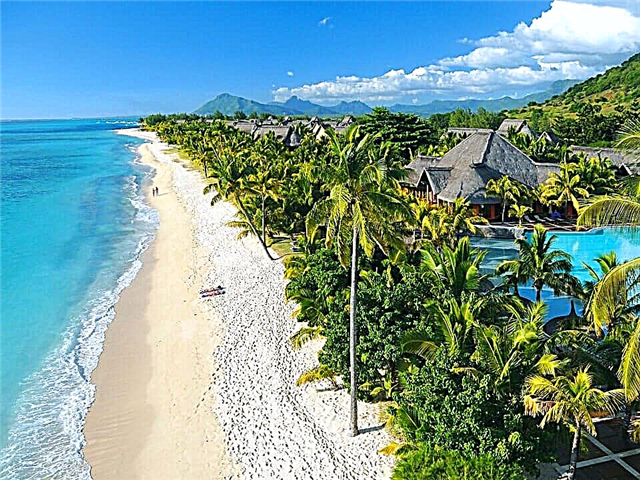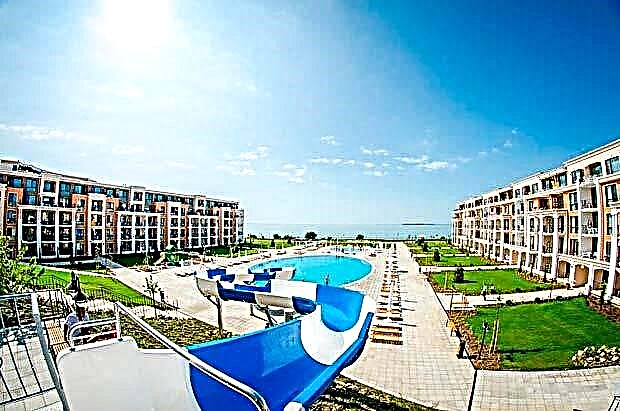The Kizicheskaya monastery has stood on the Tatar land for over 320 years. This landmark of Kazan is not as famous as the Kazan Kremlin or the Kul-Sharif mosque, but it leaves a deep impression in the hearts of tourists and believers who come to the city to worship Orthodox shrines. In honor of the male monastery, the historical part of the city was named - Kizicheskaya Sloboda and the dam, which connects the left and right banks of the Kazanka.
How the monastery was founded
In the years 1654-1655, the history of our country was a black stripe. A terrible epidemic of plague - a pestilence plague - swept across all Russian lands. First, the disease was brought to Moscow. After the first deaths, the townspeople panicked and began to hastily leave the contaminated place, abandoning their homes and all the acquired property. A few months later, a terrible disaster engulfed the entire central part of Russia.

General view of the Kizichesky Vvedensky monastery
Kazan, where many people lived, also suffered greatly from the epidemic. According to the surviving documents, in the city itself and its immediate environs more than 41 thousand people died from a pestilence in less than two years. The former capital of the Kazan Khanate was practically depopulated.
It seemed that nothing could stop the trouble, but the secular and city authorities consulted and decided to bring an icon of the Smolensk Mother of God to Kazan for prayer. The ancient image was considered miraculous and was kept in the Seedmiozernaya Theotokos monastery. While the icon was in the city, the disease receded, and the deaths from the disease stopped.

View of the Kizichesky Vvedensky Monastery from the Street of Justice
The delighted Christians perceived the intercession of the Mother of God as a real miracle and, as a token of gratitude, erected an Orthodox cross and a small chapel in Kazan. The residents decided to bring the icon to the city every year and hold a procession on the hill covered with pine trees.
In 1687, a new misfortune fell upon the citizens of Kazan - malaria, which was popularly called the "shaking disease". The disaster turned into a new epidemic, lasted about a year and claimed the lives of many adult citizens and children. When the illness receded, Metropolitan Adrian proposed to erect a new church in honor of the Cyzic martyrs at the meeting place of the miraculous icon.

View of the Church of Vladimir Equal to the Apostles Kizichesky Vvedensky Monastery
From church traditions it is known that nine Christians lived in the III century in the city of Cyzicus, in Asia Minor, and there they were martyred. By order of the Roman emperor Constantine, the remains of the saints were buried in the temple, and the tomb became miraculous. After death, the Kizicheskie righteous healed people from fever, dysentery and provided assistance in epidemics.
Kazan residents gladly supported the proposal of the Metropolitan. In 1688, the first wooden church was built, and pilgrims were drawn to the new church. Gradually, monks began to settle around the church.

View of the dome of the Church of Vladimir Equal to the Apostles
In 1691, Adrian moved to Moscow, received the rank of Patriarch and approved the status of the Holy Vvedenskaya Kizicheskoy monastery.
In 1645, Metropolitan Anempodist of Kyzikos presented pieces of the relics of saints from Kyzikos to the Russian Tsar Fyodor Mikhailovich, and in 1693 the great relic was brought from Moscow to a monastery on the Volga.
Abode in the XVII-XXI centuries

View of the Church of Vladimir Equal to the Apostles (left) and the fraternal building (center) from the territory of the monastery
For a long time, the new Kazan monastery served as the summer residence of the local metropolitan. A separate house for the bishop appeared already during the reign of Catherine II, that is, 100 years after the founding of the monastery. After the church reform, the Orthodox monastery was assigned to the third class.
The main income for the monastery was brought by pilgrims and fees during the annual processions of the cross. The monks not only prayed in temples, but also worked in the smithy, in the orchard, in the horse and cattle yards, maintained a barn, a bathhouse and a mill. The monastery owned a grove with an area of 10 acres, extensive arable land, hayfields, a large pool for fishing on the Volga and a fish pond next to the monastery.

View of the Chapel of the New Martyrs and Confessors of the Russian Church (right), the bell tower (center) and the church shop (left)
The money earned was enough for everything! For two centuries, a stone fence with four corner towers, a magnificent four-tiered bell tower 53.5 m high, an elegant chapel and a three-story building for the abbot and brethren appeared in the monastery. In addition, there was a parish school at the monastery, where illiterate children from Kizicheskaya Sloboda learned to read, write and count.
The size of the monastery cemetery in Kazan resembled the famous Moscow necropolis in Donskoy monastery... More than 3,000 people were buried here - monks and nuns of several Kazan monasteries, respected professors of the city university and representatives of families of noblemen and merchants well-known in the city. On the well-groomed graves, one could see real works of memorial sculpture.

View of the chapel of the New Martyrs and Confessors of the Russian Church
In 1918, a sharp turn took place in the life of the ancient monastery. Soon it was closed, completely ruined, and the monks and novices were expelled from their home. Icons, expensive church vestments and all silver utensils were gone.
During the years when an active struggle against religion was taking place in the country, the main monastery buildings, including the high bell tower, were destroyed. The remaining brick was collected and taken to city construction sites. The monastery cemetery was mercilessly razed to the ground and turned into a park of culture and recreation for Chemists. The surviving buildings were given to the military. For several decades they were used as a military commissariat, housing for military personnel, warehouses and garages.

View of the bell tower of the Kizichesky Vvedensky monastery
The revival of the shrine began in 2001. Initially, the diocese was given the Vladimirskaya church, which was burnt down in the fire. After a long break, in January 2002, the first service was held for Epiphany in the former monastery.
For five years, the monastery territory was completely freed from extraneous organizations and returned to believers. In 2007, the consecration of the church in honor of the Kizic saints took place, and 3 years later - the Vladimir church.

View of the Church of the Nine Martyrs of Cyzic
On the site of the former necropolis, a memorial cross was erected, on which the names of 22 eminent citizens of Kazan were written. At the entrance to the Park of Chemists, you can see the recently restored grave where the former governor of Kazan, the grandfather of the Russian writer Leo Tolstoy, Ilya Tolstoy, was buried.
Architectural ensemble
The rectangular territory of the monastery adjoins the streets of Decembrists and Justice. A large old iron gate with a wicket leads inside, behind which there is a small pretty park.

Side view of the Church of the Nine Martyrs of Cyzic
Today, there are two churches in the monastery, a chapel of the New Martyrs and Confessors of the Russian Church, a restored fraternal building and a new refectory. The warm gateway Vladimirskaya church was built in the 17th century in the early Baroque style and has undergone many alterations. The monastery buildings are painted in red and white, therefore, both in sunny and cloudy weather, they look elegant and festive.
The place of the high stone bell tower is occupied by a small beautiful hipped belfry with 9 bells, which were brought to the monastery from Yaroslavl region... Builders and restorers work in the monastery today. The monastic community plans to restore the destroyed old necropolis and the majestic Vvedensky Cathedral.

View of the belfry of the Kizichesky Vvedensky monastery
Special holidays in the monastery are May 12 - the day of memory of the Kizic saints, July 28 - the commemoration of the holy Equal-to-the-Apostles Prince Vladimir and December 4 - the Christian celebration in honor of the famous biblical event, the Entry into the Church of the Most Holy Theotokos.
Useful information for pilgrims and tourists
The territory of the monastery is open to everyone from Monday to Saturday from 7:00 to 19:00, and on Sundays from 6:00 to 19:00. Free admission. Church services are held every day - at 8:00 and 17:00. On Sundays at 6:00 an early Liturgy is served in the Vladimir Church. The prayer hall is located on the second floor of the Vladimir Church.

Currently, 10 monks and novices live in the monastery (2020). A Sunday school, a library and a sewing workshop are open at the Kizic monastery. There is a church shop.
Since the monastery is active, guests are asked to respect the monastery charter, not interfere with the conduct of church services and not make noise on the territory. It is not customary in the monastery to photograph inside the temples and to take photographs of monks. Women are asked to wear headdresses and skirts to attend temples.
How to get there

View of the fraternal building of the Kizichesky Vvedensky Monastery from the Street of Justice
The ancient monastery is located in the Moscow region of Kazan, on Dekabristov street, 98. From the metro stations "Kozya Sloboda" and "Yashlek" to the monastery 10-15 minutes walk. From the center of Kazan you can get to the monastery by city buses and trolleybuses. You need to get off at the stop “Humanitarian Institute” or “Tandem Supermarket”.
Attraction rating:











